|
RIPSTER REVIVALS #10
We're Gonna Need a Bigger Bucket List
(Another Getting Away With Murder Special)
|
Following my recent revelations about a groaning to-be-read-pile of books, I was inundated with more than one message of appreciation – particularly for reminding fans of how good Gavin Lyall was. As a consequence – and you brought this on yourself – I have been persuaded to share more of my thoughts.
But first I have an admission to make. Although retirement from front line reviewing has given me the time to tackle the to-be-read (or re-read) and hopefully cull to a manageable size the mass of crime novels and thrillers I have amassed over the decades, this has not provided me with immunity from the need to acquire new books. [Long ago the works of Raymond Chandler were identified as my gateway drug.]
As a consequence I have been forced to implement a new policy, in that for very new book I acquire, read and decide to keep, I have to – with a heavy heart – dispose of a title from my library which I think I am unlikely to re-read. This has made several bespoke book dealers very happy, which is only fair as they have provided me with so much enjoyment and occasionally enlightenment over the years.
Ghost of Honour in the Garden
To mark the publication of my twelfth and final ‘continuation’ of the adventures of Albert Campion, the ‘Golden Age’ amateur sleuth now in the Swinging Sixties, Mr Campion’s Christmas [Severn House], I took the opportunity to pose for a photograph in honour of Albert’s creator, Margery Allingham.
I am sure that the latest AI software would have enabled me to pose with Margery, who died in 1966, but such technology is beyond me and so I resorted to the use of props. In the mid-1950s, Margery was pictured in the gardens of her house in Tolleshunt D’Arcy in Essex, leaning on a favourite garden bench. Seventy years on that wrought iron garden bench now resides in the gardens of a neighbour here at Ripster Hall who kindly loaned it for the purposes of a commemorative photograph.

Mr Campion’s Christmas, a spy story set the immediate aftermath of the Cuban missile crisis of 1962, marks ten years of my tenure continuing the Campion stories of Margery Allingham and her husband Pip Youngman Carter. It has been great fun.
The Italian Job
I like to think I was one of the first of my generation to appreciate the superb spy novels of Ted Allbeury (1917-2005) whose experiences in WWII proved he knew about what he wrote. I think the first of his I read was The Lantern Network in 1979 and I still remember how the tragic story tugged at the heart strings. I was aware that Allbeury had also written a couple of non-spy thrillers under the pen-name Richard Butler, but have only just got around to reading one that has been lurking on my shelves for far too long.

Italian Assets was published in 1976, relatively early on in Allbeury’s career as a novelist (he had several other far more exciting careers) and is clearly the second in a series which never materialised, featuring a veteran of WWII in his mid-fifties now making a living on the Ligurian coast buying and selling boats. The plot hinges on the financial assets of a deceased Italian resistance leader and some unsavoury characters who feel they are entitled to them. Naturally there’s an attractive daughter who needs protecting, although rather uncomfortably fancied by the much older hero, drugs, boat chases and some ruthless violence.
It is a serviceable enough thriller and innocently politically incorrect, as when our hero declares ‘one of the things I like about Eyeties is that they say nice things about all women’. And in parts it does show its age (or perhaps I do) when one character asks for ‘a Palgrave’ to be sent from England and when, whilst observing the churning wake of a speeding boat, the hero thinks ‘a ton of Omo couldn’t have made more foam than we did’.
I do not know if Omo is still an existing brand of soap powder but it was once so popular that Music Hall comedians had a standing joke about lascivious travelling salesmen who always looked for houses with an Omo packet in the front window as this was a bored housewife signalling ‘Old Man Out’. It was a different time.
There is also one piece of wartime tradecraft which has the ring of truth about it. In a dramatic episode in the Italian mountains, our hunted hero smears the outer edges of the lenses on his binoculars with the rind of a cheese in order to stop them reflecting off the bright sunlight and giving away his position to the enemy.
We’ll Always Have Paris
I was anxious to read Len Deighton’s 1967 novel An Expensive Place To Die as soon as it came out in a five shilling (25p for younger readers) paperback edition in 1969, primarily to see if the anonymous first-person narrator of Deighton’ first four novels, now thanks to the movies known as Harry Palmer, was once again the central character. If memory serves, I decided it wasn’t, though the protagonist spies had much in common and the fact certainly did not hinder my enjoyment of the book (which I still own.)
Given that it was written (I’m guessing) in 1966, it strikes me as being totally on the ball for the time, if not ahead of the curve, when dealing with LSD and the arrival of China into the nuclear arms race.
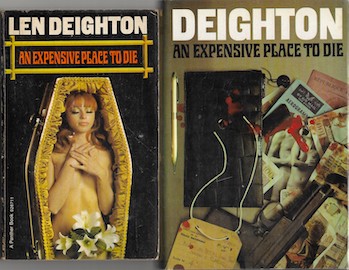
It was some thirty years later that I managed to acquire a hardback first edition which, apart from providing another enjoyable re-read, comes with a wonderful added bonus in the shape of a ‘file’ of Top Secret documents which actually, on close examination, provide a sort of prologue to the plot of the book.
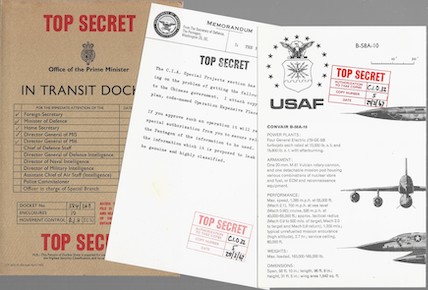
Legend has it – and like John Ford, I always print the legend – that an enterprising early purchaser of the book in Canada took the bonus, added-value inserts and attempted to sell the ‘secret file’ to the nearest Russian embassy.
One feels that was a scam of which Harry Palmer would have approved.
Meeting Heroes
I have never subscribed to the mantra that one should never meet one’s heroes. I’ve met several of mine over the years – Gavin Lyall, Elmore Leonard, Ruth Rendell, Ed McBain, Anthony Price, Alan Williams, Phyllis James and James Crumley to name-drop merely a few – and found them all interesting, charming and generous with their time when they did not have to be.
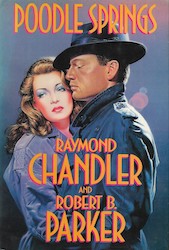
I was doubly excited, back in 1989 or 1990, to meet Robert B. Parker partly because I was a big fan of his stories about his Boston-based private eye Spenser, but mainly because I had been sent an American first edition of Poodle Springs, Parker’s continuation of the exploits of Philip Marlowe, as created by Raymond Chandler.
Whilst Bob Parker was delightful to meet, I have to admit that I was somewhat disappointed in my (now signed) copy of Poodle Springs, which was left unfinished on Chandler’s death in 1959. As a result I have avoided other attempts to take up the Marlowe mantle until now, as I have discovered The Second Murderer which was published last year, by the multi-talented Denise Mina, and this one does not disappoint

I first met Denise Mina more than twenty years ago when she was dragooned into appearing as a team member in the first public outing of the I’m Sorry I Haven’t A Cluedo quiz show (not that, I suspect, Denise could be dragooned anywhere she didn’t want to go). Her lightening wit and measured Glaswegian delivery made her an instant hit and I actually hurt after laughing so much when she went off script – a script I had written.
It never occurred to me to think of her as the natural heir to Chandler’s world of a 1940’s Californian private eye, but by God she does Raymond proud. Absent are a couple of Marlowe trade-marks – the pipe smoking and his penchant for socks with clocks on them – but I hardly missed them in The Second Murderer as Marlowe navigates a tortured path through the underground lesbian scene (brilliantly done) whilst dealing, poignantly, with alcoholics and less sympathetically with his old bête noire: the rich.
And best of all, Denise gets the acidic cadence of Marlowe’s dialogue absolutely spot on.
For legal reasons, I was unaware that Denise had picked up Philip Marlowe’s battered fedora. Similarly, I was disgracefully unaware that she had adopted the cowl and cloak of the radical 15th century Dominican friar Girolamo Savonarola, as she has in the novella Three Fires.

Famous, or infamous, for his activities in Renaissance Florence and in particular for igniting the original bonfire of the vanities, surely a crime which alone merited his grisly fate.
Denise’s take on the mad monk’s activities (okay, that might sound biased) in a Florence ruled (occasionally) by the Medicis and coveted by the Pope and the French, not to mention the Venetians, is wonderfully modern and cynical. In addition this short, punchy book is thought provoking and whilst I’m not sure I agree with the straight line connection she makes between Savonarola and eighteenth century colonialism; it is a thought I’m glad she provoked.
I am no authority on Savonarola, though I have spent an enjoyable time in his home city of Ferrara and indeed have stood on the spot in Florence where he was burned at the stake.
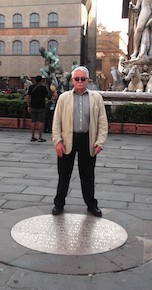
I am sure, although I have neither the learning nor the years left to do it myself, that there is a good book to be written about Savonarola and one of his faithful disciples, the artist Sandro Botticelli. If Botticelli consigned some of his paintings to Savonarola’s bonfire of the vanities as an act of religious purging, how come one of the most famous = The Birth of Venus – is in the Uffizi?
Do Mention The War
Many years ago, though not quite in the age of steam, I commuted into London daily and spent many happy hours in the bar the company of fellow traveller George Thaw, then the Books Editor for the Daily Mirror, talking about crime fiction. Incredibly well-read in the genre, and close friend to many crime writers (it was George who introduced me to Ruth Rendell and Duncan Kyle among others), I don’t think George ever got around to writing a crime novel, though he often said his ambition was to create a police detective working in wartime London. There had been plenty of thrillers and spy fiction set during WWII but not, at that time, a police procedural we could think of.
I was reminded of our discussions when placing John Gardner’s The Streets of Town in my TBR pile.
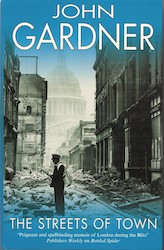
This was in fact Gardner’s second wartime crime novel to feature detective sergeant Suzie Mountford, who made her debut in Bottled Spider in 2002, and who was one of a trio of memorable protagonists created by Gardner (1926-2007) which also included Boysie Oakes and Herbie Kruger. It is a shame that the author is now probably best known for writing more James Bond books than Ian Fleming did, as many of this books stand the test of time very well and Suzie Mountford is a great character and one of special significance to her creator.
Based on an old girlfriend of Gardner’s from the 1940s, Patricia Mountford spotted her starring role as Suzie Mountford in Bottled Spider whilst in a bookshop (in Cambridge it is said) and got in touch with Gardner, then a 77-year-old widower, and romance was rekindled. There were five Suzie Mountford books in all before Gardner died in 2007, at which point he and Patricia Mountford were engaged to be married.
John Gardner may have been the first to fill what George Thaw called a ‘gap in the crime market’ but many have followed: Rennie Airth, Laura Wilson, Jim Kelly and Mark Ellis to quote only names I can see on my bookshelves. And the popularity of wartime sleuthing continues this Autumn with two new titles, both from Allison & Busby and both the latest instalments in on-going series: Mike Hollow’s The Soho Murder and Jim Eldridge’s Murder At Whitechapel Road Station.
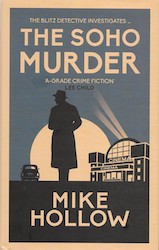
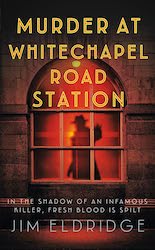
Holland and Holland
There can be few writers equally successful at producing fiction and non-fiction, but James Holland is probably among them, utilising his extensive knowledge of World War II. His novel The Odin Mission (2008) introduced Sergeant Jack Tanner, a British infantryman up against it in the Norway campaign of 1940, who went on to star in a short series and earn the label a ‘Sharpe for the Blitz years’ from the Sunday Telegraph.
It is, if one dare say it, a good old fashioned war story, which one reviewer said was ‘straight out of the pages of the old Commando comics’ and, sadly, I am old enough to know exactly what he meant by that.
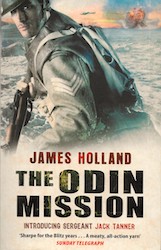

I have to admit, however, that I much prefer James Holland’s non-fiction and have just finished his detailed and majestic history of the Allied invasion of Italy in 1943, The Savage Storm (2023).
Oddly, I can say much the same about the work of James’ elder brother Tom Holland. Many years ago, I tried several of Tom’s rather Gothic novels only to find them not really to my taste.
Once he turned ‘legit’ and began to write about the ancient and early medieval world, though, I was hooked and he is one historian whose work I buy ‘sight unseen’ these days. His latest, Pax – basically Rome from Nero to Hadrian – is a belter.
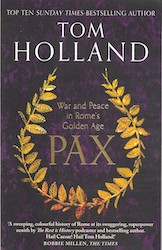
Household Item
It is always a treat to find a book in my TBR pile which I had totally forgotten I owned and doubly exciting to discover it’s a Geoffrey Household, in this case, The Three Sentinels first published in 1972.
Geoffrey Household (1900-1988) took a first in English Literature at Oxford and embarked on a variety of careers, involving being a banker in Bucharest, a banana importer in Spain and as a printer’s ink salesman in Latin America, before landing in Depression Era America where he discovered a talent for writing short stories for children, and then novels. During WWII he served in the British army in Field Security, mostly in the Middle East, but also in north Germany in 1945 where he witnessed the liberation of a Nazi concentration camp.
His most famous work, Rogue Male. Published on the outbreak of WWII, is rightly regarded as a classic and was filmed as Man Hunt during the war and then in 1976 by the BBC. The Geoffrey Household website, run by his family, has a marvellous picture of the author and star of that BBC production, Peter O’Toole, on location.
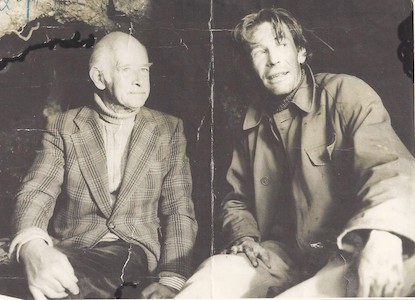 }
}
There are, I believe, plans to remake the film with Benedict Cumberbatch in the lead role.
But Geoffrey Household was no one-book wonder and I have long been a fan of his Watcher in the Shadows and A Rough Shoot as well as his Rogue Justice, the sequel to Male written some forty years later, and which I regard as a prime example of the noir thriller.
The Three Sentinels is set mostly in South America (Chile?) and is one of Household’s quieter, more ruminative novels, which is one way of saying the levels of suspense and action are rather low. The Sentinels in question are three coastal oil rigs around which a complete township of workers, company officials and their wives and children has grown up, the whole place only accessible by sea and effectively cut-off from just about everything.
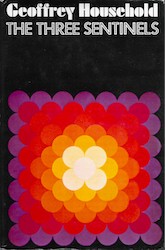
When the oil comes in and automation takes over, the owning company has little use for several hundred workers and their families. The trouble is they want to stay there in the homes and farms they have created and begin a boycott of the place, supported (or perhaps not) by their union and threatened by a corrupt police force. Into this situation the oil barons in London parachute in a middle-aged English mining engineer as a general peacekeeper and diplomat, armed basically with only his innate honesty and decency, essentially to bridge the gap between capitalism and socialism.
I felt that Household saw himself very much as the protagonist here, the epitome of the true English gentleman, though he never has to resort to violent action as many of his other heroes do so effectively. In fact, the most dangerous, and interesting, character in The Three Sentinels, is a mercenary saboteur armed with lot of explosives and no moral compass, who sadly only appears at the tail end of this story.
Anyone expecting another Rogue Male, or the atmospheric Dance of the Dwarves (also set in South America), will be disappointed but there is always much to admire in Household’s gentle prose and his stalwart belief in man’s basic decency.
Having said that, I have met people who don’t think Rogue Male is very good. There’s just no pleasing some people.
Incommunicado
Some readers will already know that my personal email account has been hacked and so the usual complaints about this column will go (as usual) unanswered. I am considering abandoning all modern technology and refreshing my membership of CAMRQPI – the Campaign for Real Quill Pens and Ink. Please pass me another sheet of vellum.
Pip! Pip!
The Ripster
OTHER RIPSTER REVIVALS:
#1: Peter Dickinson
#2: David Dodge
#3: Nevil Shute
#4: War Stories (Part 1)
#5: Walter Satterthwait
#6: War Stories (Part 2)
#7: War Stories (Part 3)
#8: William P. MacGivern
#9: Bucket List (Part 1)